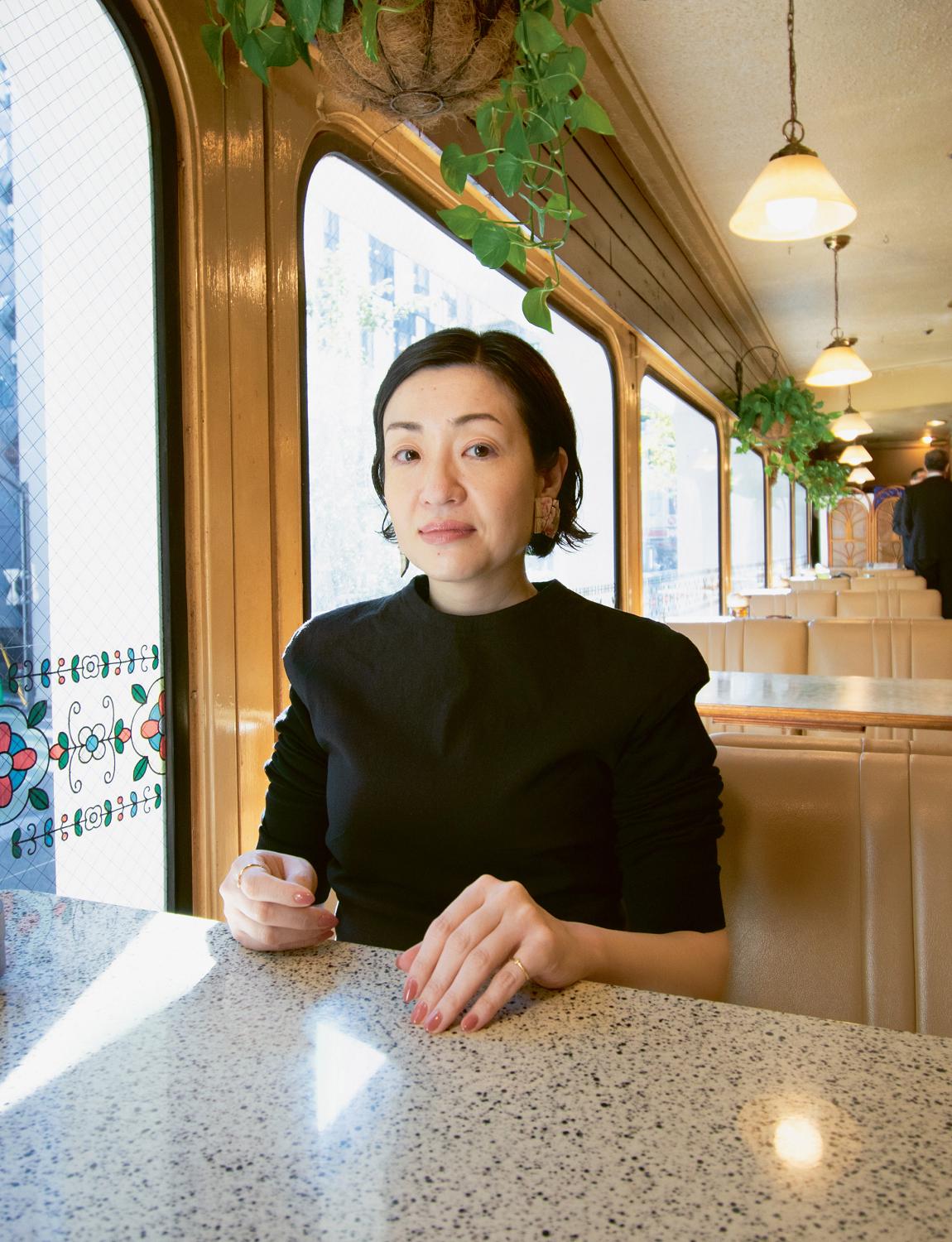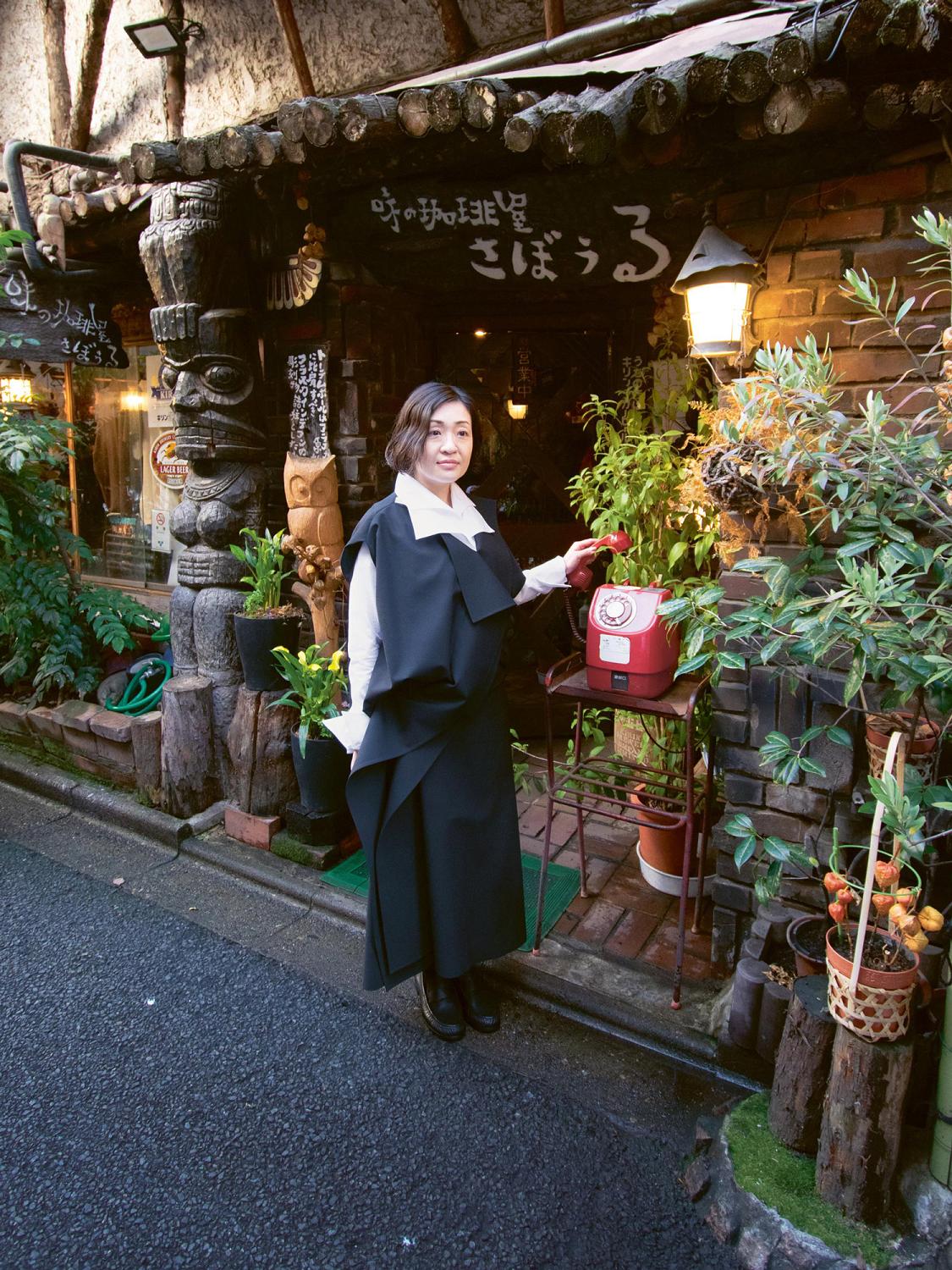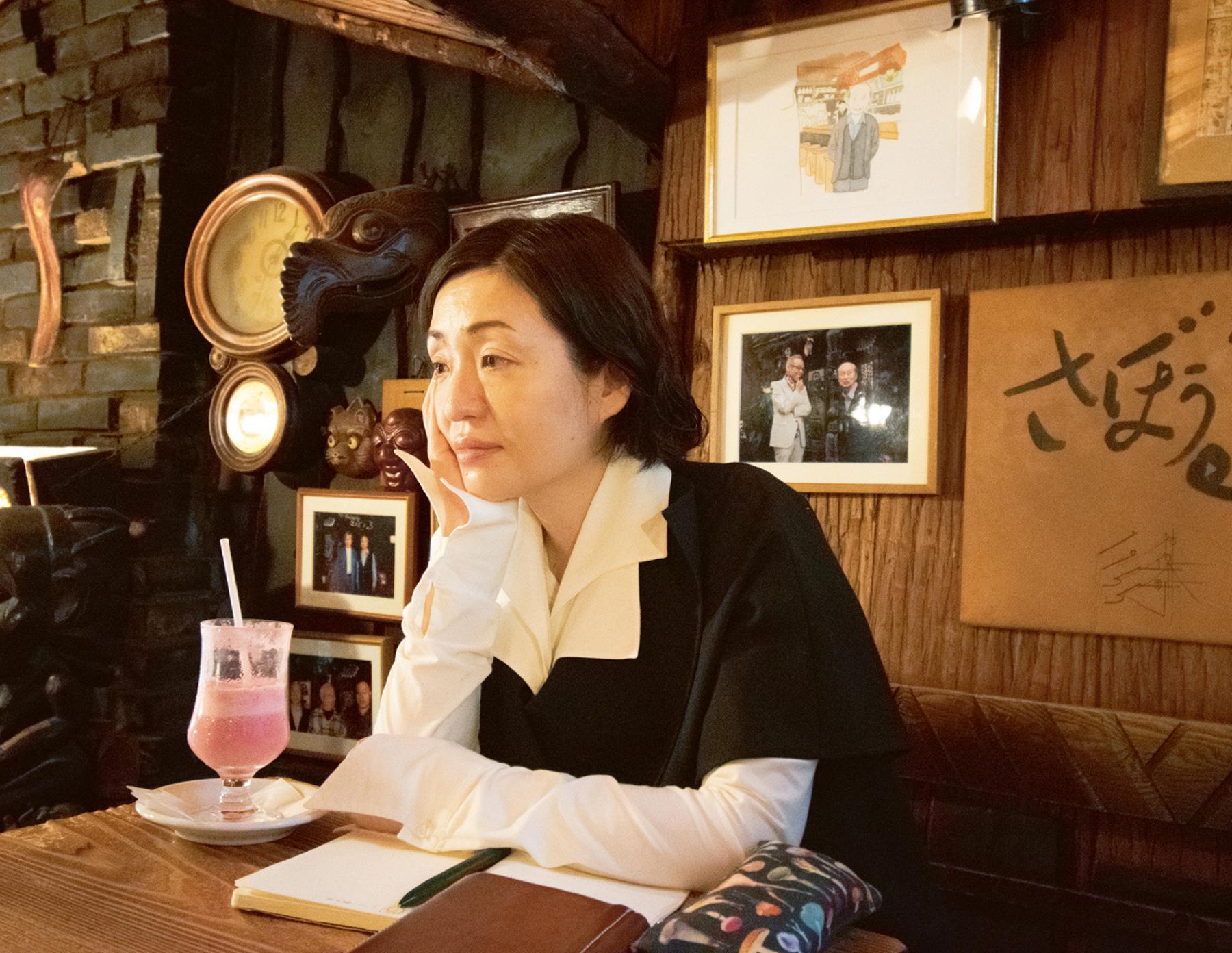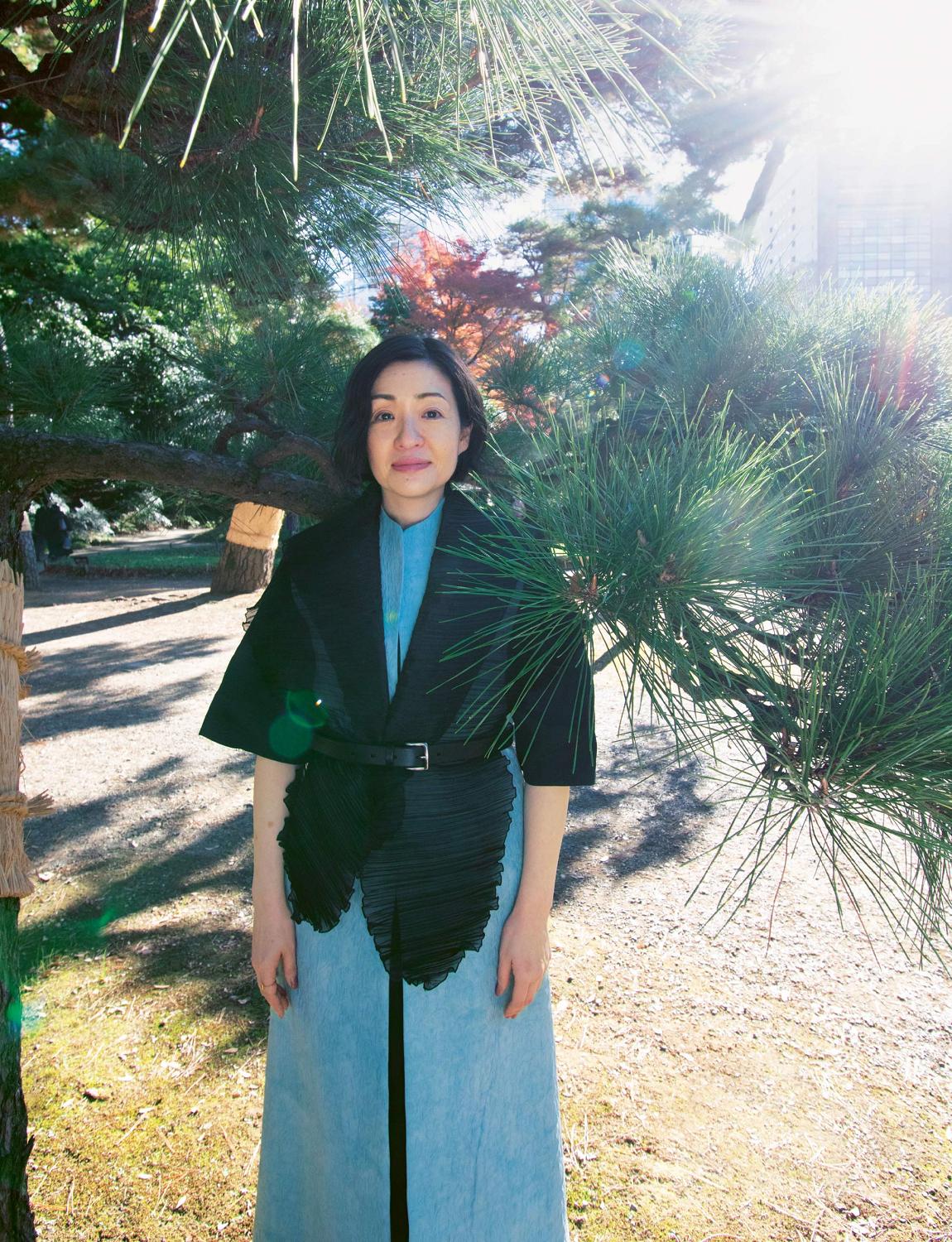Sayaka Murata
The cosmic novelist

Portraits by Fumiko Imano
Styling by Reina Ogawa Clarke
Issue nº 29, Spring and Summer 2024
The super-successful novelist Sayaka Murata resides in Tokyo but lives on a star with 30 invisible friends. Welcome to her world.
If Sayaka Murata were a character in one of her own novels, critics would complain she wasn’t a plausible protagonist. She lives, she tells me when we meet in Frankfurt in late October, on a star with 30 invisible friends – not imaginary, she corrects me, “because that would imply they don’t exist.” To her, normality as decreed by society is “a form of madness”. Friends describe her to me as an alien – her incredible imagination somehow makes her not human.
This is the same Sayaka who shot to global fame in 2018 after Konbini Ningen, which won Japan’s biggest literary prize, the biannual Akutagawa, in 2016, was translated into English as Convenience Store Woman. It was her 10th novel in Japanese but her first for anyone reading in English – superbly translated by Ginny Tapley Takemori – and has now sold more than 2 million copies in 40 countries.
The novel is about Keiko Furukura, a 36-year-old woman indifferent to her own sexuality who has worked in the same convenience store for half her life. Her family and friends despair, but Keiko enjoys feeling like a normal cog in society thanks to her job. Keiko’s story struck a chord with readers around the world, tipping Sayaka, who is now 44, from being a cult writer of odd, offbeat stor-ies seeking to expose social constructs we take for granted into someone verging on a household name. When it emerged that Sayaka, who is also unmarried, had also spent 15 years working in various convenience stores and had only quit in 2017, readers felt a kinship. The novel’s feminist undertones were a bonus in an age of #MeToo.
But then, two years later, came Earthlings, also translated by Takemori: a shocking, dark and very entertaining novel about a woman who believes she is an alien living in a town that is a factory for human babies. No topic is off limits, from child abuse and incest to violence and cannibalism. For Japanese fans this was a return to the Sayaka they knew, even if it wasn’t quite the follow-up English-speaking readers might have expected. “Earthlings brought the attention back to who she is as an author. Not every-body who enjoyed Konbini Ningen will like Earthlings,” Takemori, who has translated Sayaka since 2011, tells me over Zoom. That book was followed in 2022 by Life Ceremony, a collection of subversive short stories set in either a near future or an alternate reality, which offers a window into the full extent of Sayaka’s vivid imagination.

We meet not in a galaxy far away but in the wood-panelled bar of the luxurious Steigenberger Frankfurter Hof hotel. A pianist is playing “What a Wonderful World” rather too loudly in the lobby, little realising the irony, given that Sayaka writes to escape a world beset with problems.
Four hours earlier, I had watched her captivate an audience at the Frankfurter Buchmesse, the world’s biggest book fair, held not far from where Johannes Gutenberg invented the printing press, paving the way for the mass consumption of books. Sitting on the stage, she looked like something that had sprouted in a magical forest, her back tree-trunk straight, her long beige shirtdress stamped with a barklike print overlaid with green stripes.
She is late, having spent more than two hours signing books for a snaking line of fans. Christine, a 26-year-old student clutching the German edition of Life Ceremony, told me she loves how Sayaka rails against social standards. “What she writes is absurd, but afterwards you think, Yeah, but it could be true.”
Life Ceremony kicks off with “A First-Rate Material”, a story about using human bones, teeth, hair and skin as materials for furniture, jewellery, clothing and wedding veils with a personal touch. The title story goes further, positing a society where death is celebrated by eating the deceased. “They say you get better soup stock from men, don’t they?” someone re-marks after learning about the death of a colleague.
“Why is it so horrible? Why is it a sin?” Sayaka asked about cannibalism during her talk, recalling her fascination with the idea when she was young. “As a child I didn’t feel that eating human flesh would be that bad… Now I’ve been socialised, but if I hadn’t been, maybe I could prepare a soup from my father’s skeleton.” (Her father is still alive.)
Over mint tea in the bar, I ask her how the signing went. Her reply is pure Sayaka: disarmingly genuine and unreservedly explicit. “I feel like a lot of people have been surprised by the cannibalism element. I find that very unusual. Quite exciting.”
Sayaka is still wearing the bark dress, which was designed by Maiko Kurogouchi, a friend of her friend Mariko Asabuki, another writer. “Her designs give me energy and courage,” Sayaka says. She bought the striking diamond ring she wears on her right forefinger for herself. “It’s ‘Sa’, from Sayaka. It’s quite unusual.” (The ring’s design is the hiragana character sa, used at the end of a sentence to make a statement playfully assertive.)
It is hard to square Sayaka’s demure countenance, her chin-length, bobbed black hair tucked behind her left ear, with the thoughts whirring behind her delicate features. As we talk (via an interpreter, Bethan Jones), she is matter-of-fact about even the most outlandish sentiments. But given that the point of Sayaka’s work is to expose the absurdities and hypocrisies of various conventional beliefs, who am I to decree what constitutes outlandish? Sayaka’s characters wrestle constantly with the notion of normality, which even her friends find discombobulating. “Reading Sayaka’s work destroys all notions of ‘normal’ for me,” Kanako Nishi, a close friend and fellow writer who met Sayaka in Beijing in 2010, tells me over email. “She refuses to reconstruct normality, leaving readers questioning whether they are really normal or what normal even is. I can talk to her about my ugly feelings and secrets that I can’t tell anyone else,” she adds.
“When I’m acting the most normal is when I feel my madness the most,” Sayaka says. “Normal, for me, is something that doesn’t come from within ourselves. It’s the self that believes what society is telling us.”
“I don’t believe you need a physical body to exist.”
Sayaka was born on 14 August 1979 in her mother’s hometown of Yamagata but grew up in Inzai, a small city to the east of Tokyo, in Chiba prefecture. As a child she was “timid and lonely”, she tells me, traits she pours into many of her characters. She struggled with the notion of family. “I didn’t really understand the concept, or why my mum and dad fed me. In books and in films I could see that family was meant to stand for unconditional love, but I didn’t understand that. Because of my experience, I like imagining families that are outside the box.”
Kanako Nishi believes this perspective helped to make Sayaka into a writer. “I was speechless when she told me she didn’t understand why her parents raised her. She is an alien who has been questioning what is normal since she was a little girl, observing it from a little distance.”
Sayaka’s father was a judge; her mother, who is also still alive, was a housewife when Sayaka was young, like many women then. Sayaka has a brother, who is six years older than her and works in banking. “We didn’t play together as children,” she says. “We talk occasionally now that we are grown up. Apparently, he has read my work, but he can’t recommend it to his friends because there is too much sex.” Her parents, with whom she lived until 2020, are “afraid” to read what she writes. “I also think they don’t realise what it contains, so they are supportive,” she adds.
Sayaka got the writing bug young, starting at the age of 10 with stories that mimicked her beloved manga comics and sci-fi books (she is still a huge fan). The following year, her mother helped her buy a word processor. “Fujitsu’s Oasys,” she says, laughing. Sayaka thought it would transform her writing into physical books and was always looking for her stories in bookshops. She tells me she hit a block during high school but got going again after coming across a small writing group at college led by Akio Miyahara, a former Akutagawa Prize winner. “He really got me back into writing,” she says.
Like her, many of her cohort in the early years of the new millennium, she struggled to find work after graduation, hence settling for a part-time job in a convenience store and writing in her spare time. “In Japan there are a lot of prizes for new writers that you can apply for. If you win you can get your story published in a literary magazine, and that’s what happened to me; that’s how I found my first publisher,” she says. She received the Gunzō Prize for New Writers in 2003 for her first novel Junyū (Breastfeeding). (It was published by Kodansha in 2005.)
Jonathan Freeman, an American writer, critic and former Granta editor, tells me by email that Sayaka, who is one of the highest-selling Japanese authors in the UK, is part of a great generation of youngish Japanese writers, including Mieko Kawakami and Kanako Nishi. Like Sayaka, Nishi evokes the pressures, anger and disquiet women feel in Japan, but he believes Sayaka’s tone distinguishes her work from that of her peers. “It’s friendly, propulsive, like 18 per cent of the oxygen in the air has been replaced by helium, and so slightly unstable, like something is about to happen, which it always does.” He adds that her work feels like a dispatch from planet Sayaka, a place made by someone with “a unique point of view who also sees and feels our world deeply”.

Sayaka is pictured here and in the previous image at one of her most frequented writing spots, Sambouru cafe, in Jimbocho – a neighbourhood known locally as Tokyo’s book district. She wears the Leonie dress in black wool by THE ROW with a white shirt, black loafers and black tights, all the stylist's own.
“I’ve been socialised, but if I hadn’t been, maybe I could prepare a soup from my father’s skeleton.”
Like many Japanese women, Sayaka found the thought of motherhood suffocating. “In my early 20s, when I was at university, I had a number of heterosexual relationships, and at the time I thought: If I were to marry this person and have their child, my life would disappear. I would be their tool. There would be no time left to be me.”
The pressure on women to procreate is a recurrent theme in Sayaka’s writing, alongside childhood alienation, sexual abuse and dysfunctional families. (“It’s very hard, but I keep writing about these topics,” she tells me.) “A Clean Marriage”, her first story published in the UK, in Granta 127: Japan in 2014 (her first in English, “Lover on the Breeze”, appeared in 2011 in a Japanese anthology), tries to redefine the concept of family, skewering the notion that couples should marry for love or because they want children. In “A Clean Marriage”, when a couple does want a baby, they book an appointment at the Clean Breeder clinic, which “provides sex as a medical treatment”. It makes for a surprisingly sensible read. In the novel Satsujin Shussan (The Birth Murder), Sayaka gives men artificial uteruses. Anyone who gives birth to 10 babies can kill one person.
“She has a flat, affectless type of prose,” Ginny Tapley Takemori says. “By being non-emotional about what she writes about, she brings out the oddness. I try and keep that when translating her into English.” Takemori loves how Sayaka handles “very, very hard-hitting themes in interesting and very funny ways.” Sayaka’s next book in English (also being translated by Takemori) will be Vanishing World (Shōmetsu Sekai), due for release in 2025, a decade after its publication in Japan. It depicts a society where sex has disappeared and people, irrespective of gender, give birth via artificial insemination.
Sex for Sayaka is off the menu now, she tells me. “I am not looking for heterosexual relationships. I feel like I haven’t had time to think about my sexuality. As a young woman, I felt we were so commoditised that we were in a fog and there was no time to think about what we wanted. Now, I can’t imagine having a sexual relationship with a physical human male.” We discuss how sex crime is rife in Japan, a country that until June 2023 hadn’t changed its rape laws in more than a century. Now, finally, new legislation has raised the age of sexual consent from 13 to 16 and tightened the definition of rape. “I don’t think any of my friends have grown up without being groped at some point,” says Sayaka, who switches from making eye contact while I’m asking questions to glancing at the sky when answering, as if seeking higher guidance.
In a practical sense, Sayaka lives alone in a two-room apartment near Shinjuku Gyoen National Garden in Tokyo. But in her heart she lives somewhere less tangible, with people who she can see but others can’t, only stepping out of her fantasy world to write – though, to be fair, she does hang out with writer friends such as Kanako Nishi. “It’s not like we always talk about writing, but I like talking about how we think and how we see things. When I’m alone, I like walking.” She reads widely, mainly women, and cites Rieko Matsuura, Hiromi Kawakami, Natsuko Imamura, and Mariko Asabuki as particular favourites.
“In the first year of primary school, when I was particularly lonely, one of my invisible friends came in through my window, and since then I have lived on the star that they live on,” she explains. “There are more than 30 people who live there, but three that I am particularly close to, [including] one I think I will be close to for the rest of my life.” Later, over email, she adds, “I feel as if the word ‘imaginary’ denies their existence, so I don’t use it any more myself. I don’t believe you need a physical body to exist.”
“Apparently, my brother has read my work, but he can’t recommend it to his friends because there is too much sex.”
“I like talking about my invisible friends, but my doctor says it will make me ill if I talk too much. So I am careful to control what I say,” she tells me in Frankfurt. Later, again by email, she touches on her health issues. “Since I made my debut 20 years ago, I’ve experienced symptoms of dysautonomia – like not being able to stand up because of vertigo – and have been under the care of the department of psychosomatic medicine. I have had counselling as well, but it’s normally the hospital doctor(s) I talk with, and I also take medication every day. I still am not able to leave the house without taking medication.”
She is calm as she talks; indeed, she never gets angry. “I think I suffered so much as a child that I wouldn’t have been able to grow up if my ability to feel anger hadn’t been broken,” she says. This trait underpins a character in her latest writing project, World 99, a novel being published in 40 instalments in the Japanese literary magazine Subaru. “I thought it would be quite a gentle story, but it turns out that I am writing about things that I think are quite taboo to do with pregnancy and childbirth.” Sayaka started this story two years ago in the same way she starts all her work: sketching out her protagonist (“Not only her face, but also her clothes and height, to know where she sees the world from,” she told Louisiana Channel last year) and other characters in a notebook, then “dropping” them into what she describes as a “fish tank” – also drawn in her notebook – so she can watch what happens. “They automatically start talking to each other.” She gestures with her hands: the “tank” is about half a metre long. She adds other characters and watches them interact. If they get along, it’s boring, so she will add a character that creates friction. “Scenes appear from there. It’s like an experiment, and I note everything down,” she has said. “I’m not good at writing based on facts,” she tells me now, “which is why I draw my characters, and I try and think about their history and their life story and the environment they grew up in.” Her degree at Tokyo’s Tamagawa University was in art curation; the course combined art, music, literature and theatre.
I ask to see her latest notebook, but she declines because she hasn’t finished her story. Nothing gets planned first, not even the genre. “I never know whether [my story] will be set in the real world or how that world will change as I’m writing.” She writes both longhand in her notebooks – “Moleskine’s Classic collection, dark blue for novels, using a dark and soft 2B mechanical pencil” – and on an iPad with a keyboard attached, always while out and about, “old coffee shops, Sabouru in Jimbocho, Lion Cafe in Shibuya. Ideally, I like to be having my breakfast [sweet bread with jam and coffee] in a cafe, or at the latest eating lunch [a sandwich and tea] in a cafe, and writing there. Sometimes I write in my publisher’s canteen.” One hangover from all those years in noisy convenience stores is that she needs background buzz to get her creative juices flowing. She even wrote on the plane to Frankfurt. “Sad scenes,” she says.
“The way I write is that I won’t betray the story, even if I end up betraying humanity. I write the words required for the story to exist. I was taught that the story is a musical score: the writer is the composer, and the reader is the performer. I believe that the writer and the performer of the score are equally important.”

Here, Sayaka takes a break in Shinjuku Gyoen National Garden, wearing a blue sleeveless jacket by MAME KUROGOUCHI over a black linen shirt and black cotton trousers, both by MARGARET HOWELL. The scarf and belt are the stylist’s own. Cosmic!
Susie MesureSusie Mesure is a freelance writer and reviewer based in London who excels at interviewing authors about their latest work. Her Instagram account is a must for fellow fans of portraiture featuring women reading.read more Portraits by
Fumiko ImanoBorn in Japan and raised in Rio de Janeiro, Fumiko Imano attended Central St. Martins before studying photography at The London College of Fashion. She is known for her self-portraiture in which she is sometimes accompanied by an identical but fictional twin sister. The duo has appeared in campaigns…read more Styling by
Reina Ogawa ClarkeFreelance stylist and vintage clothing collector extraordinaire, Reina Ogawa Clarke is a regular contributor to publications such as More or Less Mag and WSJ Magazine and works with brands including Dior, Hermès, Mame Kurogouchi and Nike. Reina, who splits her time between London and Tokyo, was photographed…read more
Hair and make up: Naho Ikeda. Production: Kontakt.
This profile was originally published in The Gentlewoman nº 29, Spring and Summer 2024.